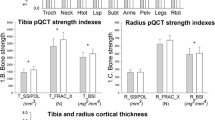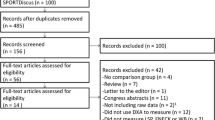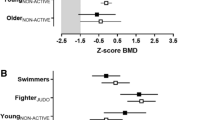Abstract
Swimming is a popular activity for Australian women with proven cardiovascular benefits yet lacks the features thought necessary to stimulate positive adaptive changes in bone. Given that peak bone mass is attained close to the end of the second decade, we asked whether swimming was negatively associated with bone mineral density in premenopausal women beyond this age. Bone mass and retrospective physical activity data were gathered from 43 female swimmers and 44 controls (mean ages 40.4 and 43.8 years, respectively). Swimmers were recruited from the Australian Union of Senior Swimmers International while controls were healthy community dwellers with similar lean mass, fat mass, height, weight and body mass index. None of the participants had a history of medical complaints nor use of medications known to affect bone. Dual energy X-ray absorptiometry was used to determine areal bone mineral density at total body, lumbar spine, proximal femur, distal radius and tibia while self-administered questionnaires were used to approximate historical and recent physical activity and calcium intake. Swimmers had averaged over 2 hours of swimming per week for the past 5 years and 1.45 h/week over lifetime with no systematic swimming exposure for controls. Lifetime exposure to weight bearing and impact exercise were similar. There were no intergroup differences for bone mass at any site though controls had higher incidence of low bone mass/osteoporosis. No differences in bone mass were detected between swimmers in the upper and lower quartiles for swim participation for any period. Long-term swim participation did not compromise areal bone mineral density.
Similar content being viewed by others
References
Ainsworth BE, Haskell WL, Leon AS, Jacobs DR Jr, Montoye HJ, Sallis JF, Paffenbarger RS Jr (1993) Compendium of physical activities: energy costs of human movement. Med Sci Sports Exerc 25:71–80
Ainsworth BE, Haskell WL, Whitt MC, Irwin ML, Swartz AM, Strath SJ, O’Brien WL, Bassett DR Jr, Schmitz KH, Emplaincourt PO, Jacobs DR Jr, Leon AS (2000) Compendium of physical activities: an update of activity codes and MET intensities. Med Sci Sports Exerc 32(9 Suppl):S498–S504
Australian Bureau of Statistics (2011) Report 4156.0: Sports and physical recreation: a statistical overview, Australia, 2011. Section 3.4 Participants http://www.abs.gov.au/ausstats/
Bergmann P, Body JJ, Boonen S, Boutsen Y, Boutsen J, Devogelaer JP, Goemaere S, Kaufman J, Reginster JY, Rozenberg S (2011) Loading and skeletal development and maintenance. J Osteoporos. doi:10.4061/2011/786752
Dalkiranis A, Patsanas T, Papadopoulou SK, Gissis I, Denda O, Mylonas A (2006) Bone mineral density in fin swimmers. J Hum Mov Stud 50(1):19–28
Emslander HC, Sinaki M, Muhs JM, Chao EY, Wahner HW, Bryant SC, Riggs BL, Eastell R (1998) Bone mass and muscle strength in female college athletes (runners and swimmers). Mayo Clin Proc 73(12):1151–1160
Engelke K, Kemmler W, Lauber D, Beeskow C, Pintag R, Kalender WA (2006) Exercise maintains bone density at spine and hip EFOPS: a 3-year longitudinal study in early postmenopausal women. Osteoporos Int 17(1):133–142
Falk B, Bronshtein Z, Zigel L, Constantini N, Eliakim A (2004) Higher tibial quantitative ultrasound in young female swimmers. Br J Sports Med 38(4):461–465
Ferry B, Duclos M, Burt L, Therre P, Le Gall F, Jaffré C, Courteix D (2011) Bone geometry and strength adaptations to physical constraints inherent in different sports: comparison between elite female soccer players and swimmers. J Bone Miner Metab 29(3):342–351
Guadalupe-Grau A, Fuentes T, Guerra B, Calbet JA (2009) Exercise and bone mass in adults. Sports Med 39(6):439–468
Harumia Y, Takao S, Satoru Y (2000) The relationship between swimming exercise and bone density. A cohort study among middle-aged women. Dokkyo J Med Sci 27(1):105–111
Kohrt WM, Barry DW, Schwartz RS (2009) Muscle forces or gravity: what predominates mechanical loading on bone? Med Sci Sports Exerc 41(11):2050–2055
Kriska AM, Caspersen CJ (1997) Introduction to a collection of physical activity questionnaires. Med Sci Sports Exerc 29(6):5–9
Kriska AM, Sandler RB, Cauley JA, LaPorte RE, Hom DL, Pambianco G (1988) The assessment of historical physical activity and its relation to adult bone parameters. Am J Epidemiol 127(5):1053–1063
LaMothe JM, Hamilton NH, Zernicke RF (2005) Strain rate influences periosteal adaptation in mature bone. Med Eng Phys 27(4):277–284
Lei SF, Chen Y, Xiong DH, Li LM, Deng HW (2006) Ethnic difference in osteoporosis-related phenotypes and its potential underlying genetic determination. J Musculoskelet Neuronal Interact 6(1):36–46
Liu L, Maruno R, Mashimo T, Sanka K, Higuchi T, Hayashi K, Shirasaki Y, Mukai N, Saitoh S, Tokuyama K (2003) Effects of physical training on cortical bone at midtibia assessed by peripheral QCT. J Appl Physiol 95(1):219–224
Magkos F, Yannakoulia M, Kavouras SA, Sidossis LS (2007) The type and intensity of exercise have independent and additive effects on bone mineral density. Int J Sports Med 28(9):773–779
Martyn-St James M, Carroll S (2009) Strength training combined with plyometric jumps in adults: sex differences in fat-bone axis adaptations. J Appl Physiol 107(2):636
Nichols JF, Palmer JE, Levy SS (2003) Low mineral density in highly trained male master cyclists. Osteoporos Int 14:644–649
Nikander R, Kannus P, Dastidar P, Hannula M, Harrison L, Cervinka T, Narra NG, Aktour R, Arola T, Eskola H, Soimakallio S, Heinonen A, Hyttinen J, Sievänen H (2009) Targeted exercises against hip fragility. Osteoporos Int 20(8):1321–1328
Nikander K, Sievanen H, Heinonen A, Daly R, Uusi-Rasi K, Kannus P (2010) Targeted exercise against osteoporosis: A systematic review and meta-analysis for optimising bone strength throughout life BMC Medicine 8:47. http://www.biomedcentral.com/1741-7015/8/47
Pavy-Le Traon A, Heer M, Narici MV, Rittweger J, Vernikos J (2007) From space to Earth: advances in human physiology from 20 years of bed rest studies (1986–2006). Eur J Appl Physiol 101:143–194
Rector RS, Rogers R, Ruebel M, Hinton PS (2008) Participation in road cycling vs running is associated with lower bone mineral density in men. Metabolism 57(2):226–232
Risser WL, Lee EJ, LeBlanc A, Poindexter HB, Risser JM, Schneider V (1990) Bone density in eumenorrheic female college athletes. Med Sci Sports Exerc 22(5):570–574
Robling AG, Hinant FM, Burr DB, Turner CH (2002) Improved bone structure and strength after long-term mechanical loading is greatest if loading is separated into short bouts. J Bone Miner Res 17(8):1545–1554
Robling AG, Castillo AB, Turner CH (2006) Biomechanical and molecular regulation of bone. Annu Rev Biomed Eng 8:455–498
Sanders KM, Nowson CA, Kotowicz MA, Briffa K, Devine A, Reid IR (2009) Calcium and bone health: position statement for the Australian and New Zealand Bone and Mineral Society, Osteoporosis Australia and the Endocrine Society of Australia. MJA 190(6):316–320
Smathers AM, Bemben MG, Bemben DA (2009) Bone density comparisons in male competitive road cyclists and untrained controls. Med Sci Sports Exerc 41(2):290–296
Taaffe DR, Snow-Harter C, Connolly DA, Robinson TL, Brown MD, Marcus R (1995) Differential effects of swimming versus weight-bearing activity on bone mineral status of eumenorrheic athletes. J Bone Min Res 10(4):586–593
Turner CH, Robling AG (2003) Designing exercise regimens to increase bone strength. Exerc Sport Sci Rev 31(4):45–50
Turner CH, Robling AG (2004) Exercise as an anabolic stimulus for bone. Curr Pharm Des 10(21):2629–2641
Velez NF, Zhang A, Stone B, Perera S, Miller M, Greenspan SL (2008) The effect of moderate impact exercise on skeletal integrity in master athletes. Osteoporos Int 19(10):1457–1464
Warner SE, Shea JE, Miller SC, Shaw JM (2006) Adaptations in cortical and trabecular bone in response to mechanical loading with and without weight bearing. Calcif Tissue Int 79(6):395–403
Conflict of interest
There are no conflicts of interest for any of the authors.
Author information
Authors and Affiliations
Corresponding author
Additional information
Communicated by Susan A. Ward.
Rights and permissions
About this article
Cite this article
Greenway, K.G., Walkley, J.W. & Rich, P.A. Does long-term swimming participation have a deleterious effect on the adult female skeleton?. Eur J Appl Physiol 112, 3217–3225 (2012). https://doi.org/10.1007/s00421-011-2305-5
Received:
Accepted:
Published:
Issue Date:
DOI: https://doi.org/10.1007/s00421-011-2305-5




